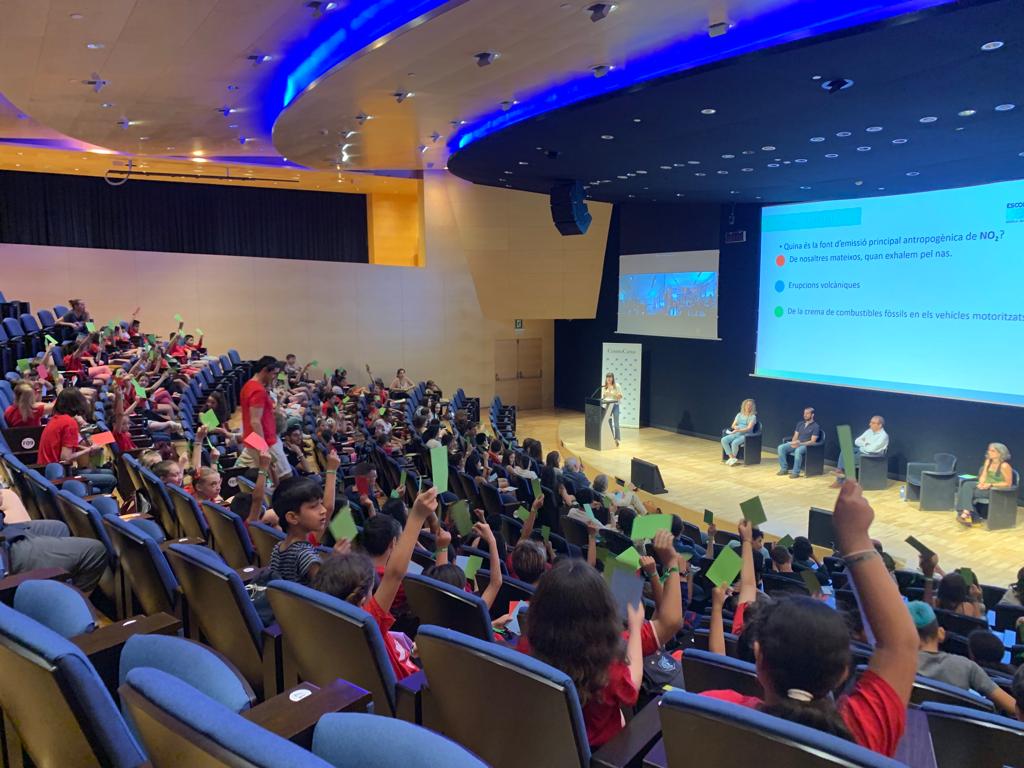The “Escoles Sentinella” network proves the safety of schools concerning COVID-19 and presents the results of the second year of the project at the project congress

- "Escoles Sentinella" has identified areas and methodologies for improvement that can be incorporated into policies to prevent infections with SARS-CoV-2 and other pathogens in the coming years.
- The "Escoles Sentinella" network monitors SARS-CoV-2 infection and its determinants in the school environment, including CO2 levels in classrooms, through a participatory research approach by the educational community and incorporating participants' recommendations.
This June, coinciding with the end of the school year, the "Escoles Sentinella" network concludes the second course for monitoring and evaluating the COVID-19 pandemic in the school environment in Catalonia, with the participation of 5,950 people from 23 schools.
The "Escoles Sentinella" network is a research project promoted by the Department of Health and the Department of Education and funded by the Directorate General of Health Planning. Its main objective is to monitor the infection by SARS-CoV-2 and its biological, behavioural determinants and structural in the school environment by studying the levels of CO2 in the classrooms, the transmissibility of the infection and carrying out participatory research as a tool to give voice to the participants.
The team of the Center for Epidemiological Studies on Sexually Transmitted Infections and AIDS in Catalonia (CEEISCAT), as a research group of the Germans Trias i Pujol Research Institute (IGTP), coordinates the "Escoles Sentinella" network and is responsible for the study of bio-behavioural factors (knowledge, attitudes and behaviours towards the SARS-CoV-2 pandemic), the collection of biological samples and the impact on emotional well-being and other social and economic aspects. The most recent data, from May 2022, indicates the percentage of antibodies among the staff of the schools and the ESO, Bachillerato and Training Cycles students has gone from being between 14% -22%, at the beginning of the project, to be above 97% in all these groups. The increase in antibodies in Kindergarten and Primary students also show a significant increase of up to 46% and 75%, respectively. These increases reflect both exposure to the virus, especially the Omicron variant, and vaccine coverage, which varies slightly by age group.
On the other hand, the team of the Institute of Global Health of Barcelona (ISGlobal) is in charge of the environmental assessment carrying out a series of interventions in the classrooms to measure and study the level of dioxide of carbon in classrooms, an indicator of air quality and therefore indirectly of ventilation. 79% of classrooms studied were below the recommended 700 ppm (part per million) carbon dioxide to decrease the transmissibility of SARS-CoV-2 infection in classrooms.
As for the Pediatric Service of the Vall d'Hebron University Hospital, which is in charge of studying in-depth the positive cases of COVID-19, during this second year it has carried out a study on whether there is any relationship between the absence of students and the levels of carbon dioxide in the classrooms. 127 students from different classrooms selected based on their CO2 levels have participated in the study. There have been 31 cases that have been contacted by telephone in which it has been found that 10% of these corresponded to a diagnosis of COVID-19, the remaining cases have been upper respiratory tract infections, bronchitis, gastroenteritis or fever, among others.
Finally, the IrsiCaixa Health Living Lab, the team in charge of implementing participatory research, has carried out a series of workshops and activities where the focus has been on improving mental health in the wake of the pandemic and a total of 17 schools, more than 40 teachers and 1,600 students and their families have taken part. As a result of this participatory research, 29 recommendations have been drafted for the improvement of the mental health promotion model in the classrooms of Catalonia, which have been divided into 5 axes: mental and social health, participation of the educational community and others. actors, communication and education, social inequalities, cultural diversity and the digital divide and the adaptation of infrastructures.
II Sentinel Schools Congress
The results obtained from the second year of the project have been presented to the entire Sentinel Schools network at the II Sentinel Schools Congress: Health research with and for the educational community that took place on June 2 in the CosmoCaixa auditorium (Barcelona) and where more than 350 students and teachers from the 23 schools in the network participated. The day was inaugurated by Dra. Carmen Cabezas, Secretary of Public Health, and Mrs Núria Mora, Secretary of Educational Transformation, represent the Department of Health and the Department of Education of the Generalitat de Catalunya, which are the institutions that promote the project.
The undisputed prominence during the Congress was given by the students of the participating schools with various presentations and readings. The students of the Olivar Gran Institute (Figueres), the Mercè Rodoreda School (Barcelona) and the Torre Vicens Institute (Lleida) presented to the whole audience the participatory research activities they have implemented throughout this course under the umbrella of the Sentinel Schools network: such as a nerve and frustration management workshop, an Emociometre to learn how to identify the emotions we feel, or a mindfulness session for the whole room, among others. The students also read the 29 recommendations made by the educational community to improve the promotion of mental health in schools. The schools that attended the conference in person were able to read them from the stage, and the rest of the participating schools connected live to present their part.

